Previously I have demonstrated that changes in atmospheric CO2 levels follow changes in Global Mean Temperatures (GMT) as shown by satellite measurements from University of Alabama at Huntsville (UAH). That background post is reprinted later below.
My curiosity was piqued by the remarkable GMT spike starting in January 2023 and rising through April 2024, the monthly anomaly increasing from -0.04C to +1.05C last month. The chart above shows the two monthly datasets: CO2 levels in blue reported at Mauna Loa, and Global temperature anomalies reported by UAH, both up to April 2024. Would such a sharp increase in temperature be reflected in rising CO2 levels, according to the successful mathematical forecasting model?
The answer is yes: that temperature spike results
in a corresponding CO2 spike as expected.
Above are UAH temperature anomalies compared to CO2 monthly changes year over year.
Changes in monthly CO2 synchronize with temperature fluctuations, which for UAH are anomalies now referenced to the 1991-2020 period. CO2 differentials are calculated for the present month by subtracting the value for the same month in the previous year (for example April 2024 minus April 2023). Temp anomalies are calculated by comparing the present month with the baseline month. Note the recent CO2 upward spike following the temperature spike.
The final proof that CO2 follows temperature due to stimulation of natural CO2 reservoirs is demonstrated by the ability to calculate CO2 levels since 1979 with a simple mathematical formula:
For each subsequent year, the co2 level for each month was generated
CO2 this month this year = a + b × Temp this month this year + CO2 this month last year
The values for a and b are constants applied to all monthly temps, and are chosen to scale the forecasted CO2 level for comparison with the observed value. Here is the result of those calculations.
In the chart calculated CO2 levels correlate with observed CO2 levels at 0.9987 out of 1.0000. This mathematical generation of CO2 atmospheric levels is only possible if they are driven by temperature-dependent natural sources, and not by human emissions which are small in comparison, rise steadily and monotonically. For a more detailed look at the recent fluxes, here are the results since 2015, an ENSO neutral year.
For this recent period, the calculated CO2 values match the annual peaks, while some annual generated minimums of CO2 are slightly lower than those observed at that time of year, which tends to be Sept.-Nov. Still the correlation for this period is 0.9913.
Key Point
Changes in CO2 follow changes in global temperatures on all time scales, from last month’s observations to ice core datasets spanning millenia. Since CO2 is the lagging variable, it cannot logically be the cause of temperature, the leading variable. It is folly to imagine that by reducing human emissions of CO2, we can change global temperatures, which are obviously driven by other factors.
Background Post Temperature Changes Cause CO2 Changes, Not the Reverse
This post is about proving that CO2 changes in response to temperature changes, not the other way around, as is often claimed. In order to do that we need two datasets: one for measurements of changes in atmospheric CO2 concentrations over time and one for estimates of Global Mean Temperature changes over time.
Climate science is unsettling because past data are not fixed, but change later on. I ran into this previously and now again in 2021 and 2022 when I set out to update an analysis done in 2014 by Jeremy Shiers (discussed in a previous post reprinted at the end). Jeremy provided a spreadsheet in his essay Murray Salby Showed CO2 Follows Temperature Now You Can Too posted in January 2014. I downloaded his spreadsheet intending to bring the analysis up to the present to see if the results hold up. The two sources of data were:
Temperature anomalies from RSS here: http://www.remss.com/missions/amsu
CO2 monthly levels from NOAA (Mauna Loa): https://www.esrl.noaa.gov/gmd/ccgg/trends/data.html
Changes in CO2 (ΔCO2)
Uploading the CO2 dataset showed that many numbers had changed (why?).
The blue line shows annual observed differences in monthly values year over year, e.g. June 2020 minus June 2019 etc. The first 12 months (1979) provide the observed starting values from which differentials are calculated. The orange line shows those CO2 values changed slightly in the 2020 dataset vs. the 2014 dataset, on average +0.035 ppm. But there is no pattern or trend added, and deviations vary randomly between + and -. So last year I took the 2020 dataset to replace the older one for updating the analysis.
Now I find the NOAA dataset starting in 2021 has almost completely new values due to a method shift in February 2021, requiring a recalibration of all previous measurements. The new picture of ΔCO2 is graphed below.
The method shift is reported at a NOAA Global Monitoring Laboratory webpage, Carbon Dioxide (CO2) WMO Scale, with a justification for the difference between X2007 results and the new results from X2019 now in force. The orange line shows that the shift has resulted in higher values, especially early on and a general slightly increasing trend over time. However, these are small variations at the decimal level on values 340 and above. Further, the graph shows that yearly differentials month by month are virtually the same as before. Thus I redid the analysis with the new values.
Global Temperature Anomalies (ΔTemp)
The other time series was the record of global temperature anomalies according to RSS. The current RSS dataset is not at all the same as the past.
Here we see some seriously unsettling science at work. The purple line is RSS in 2014, and the blue is RSS as of 2020. Some further increases appear in the gold 2022 rss dataset. The red line shows alterations from the old to the new. There is a slight cooling of the data in the beginning years, then the three versions mostly match until 1997, when systematic warming enters the record. From 1997/5 to 2003/12 the average anomaly increases by 0.04C. After 2004/1 to 2012/8 the average increase is 0.15C. At the end from 2012/9 to 2013/12, the average anomaly was higher by 0.21. The 2022 version added slight warming over 2020 values.
RSS continues that accelerated warming to the present, but it cannot be trusted. And who knows what the numbers will be a few years down the line? As Dr. Ole Humlum said some years ago (regarding Gistemp): “It should however be noted, that a temperature record which keeps on changing the past hardly can qualify as being correct.”
Given the above manipulations, I went instead to the other satellite dataset UAH version 6. UAH has also made a shift by changing its baseline from 1981-2010 to 1991-2020. This resulted in systematically reducing the anomaly values, but did not alter the pattern of variation over time. For comparison, here are the two records with measurements through December 2023.
Comparing UAH temperature anomalies to NOAA CO2 changes.
Here are UAH temperature anomalies compared to CO2 monthly changes year over year.
Changes in monthly CO2 synchronize with temperature fluctuations, which for UAH are anomalies now referenced to the 1991-2020 period. As stated above, CO2 differentials are calculated for the present month by subtracting the value for the same month in the previous year (for example June 2022 minus June 2021). Temp anomalies are calculated by comparing the present month with the baseline month.
The final proof that CO2 follows temperature due to stimulation of natural CO2 reservoirs is demonstrated by the ability to calculate CO2 levels since 1979 with a simple mathematical formula:
For each subsequent year, the co2 level for each month was generated
CO2 this month this year = a + b × Temp this month this year + CO2 this month last year
Jeremy used Python to estimate a and b, but I used his spreadsheet to guess values that place for comparison the observed and calculated CO2 levels on top of each other.
In the chart calculated CO2 levels correlate with observed CO2 levels at 0.9986 out of 1.0000. This mathematical generation of CO2 atmospheric levels is only possible if they are driven by temperature-dependent natural sources, and not by human emissions which are small in comparison, rise steadily and monotonically.
Comment: UAH dataset reported a sharp warming spike starting mid year, with causes speculated but not proven. In any case, that surprising peak has not yet driven CO2 higher, though it might, but only if it persists despite the likely cooling already under way.
Previous Post: What Causes Rising Atmospheric CO2?
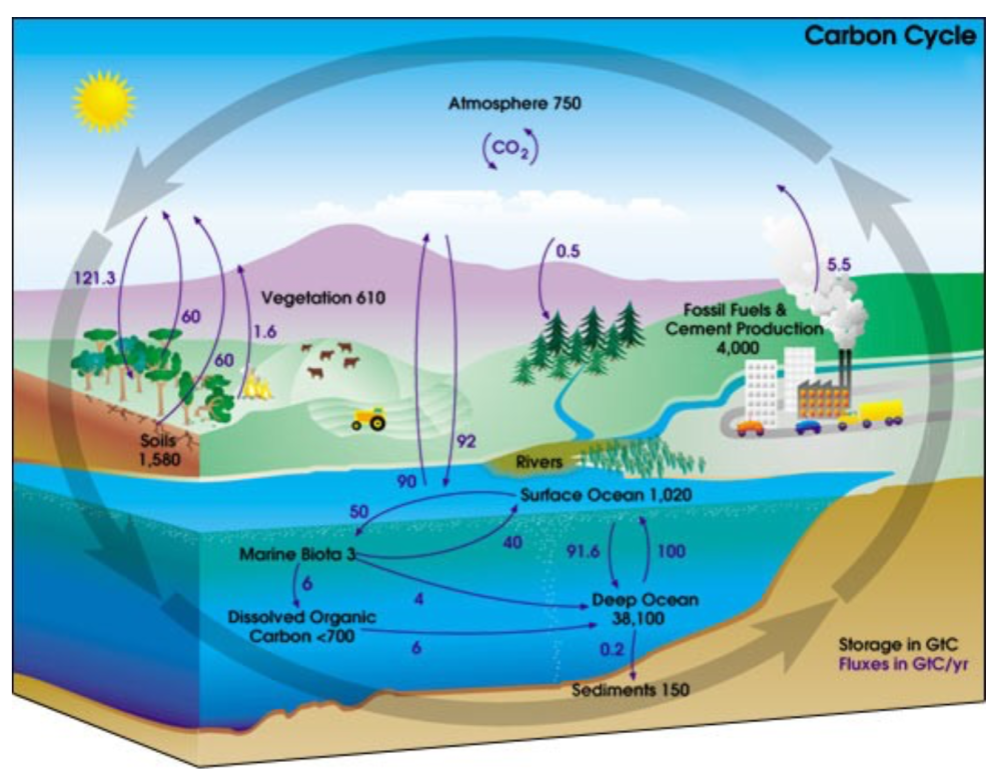
This post is prompted by a recent exchange with those reasserting the “consensus” view attributing all additional atmospheric CO2 to humans burning fossil fuels.
The IPCC doctrine which has long been promoted goes as follows. We have a number over here for monthly fossil fuel CO2 emissions, and a number over there for monthly atmospheric CO2. We don’t have good numbers for the rest of it-oceans, soils, biosphere–though rough estimates are orders of magnitude higher, dwarfing human CO2. So we ignore nature and assume it is always a sink, explaining the difference between the two numbers we do have. Easy peasy, science settled.
What about the fact that nature continues to absorb about half of human emissions, even while FF CO2 increased by 60% over the last 2 decades? What about the fact that in 2020 FF CO2 declined significantly with no discernable impact on rising atmospheric CO2?

These and other issues are raised by Murray Salby and others who conclude that it is not that simple, and the science is not settled. And so these dissenters must be cancelled lest the narrative be weakened.
The non-IPCC paradigm is that atmospheric CO2 levels are a function of two very different fluxes. FF CO2 changes rapidly and increases steadily, while Natural CO2 changes slowly over time, and fluctuates up and down from temperature changes. The implications are that human CO2 is a simple addition, while natural CO2 comes from the integral of previous fluctuations. Jeremy Shiers has a series of posts at his blog clarifying this paradigm. See Increasing CO2 Raises Global Temperature Or Does Increasing Temperature Raise CO2 Excerpts in italics with my bolds.
The following graph which shows the change in CO2 levels (rather than the levels directly) makes this much clearer.

Note the vertical scale refers to the first differential of the CO2 level not the level itself. The graph depicts that change rate in ppm per year.
There are big swings in the amount of CO2 emitted. Taking the mean as 1.6 ppmv/year (at a guess) there are +/- swings of around 1.2 nearly +/- 100%.
And, surprise surprise, the change in net emissions of CO2 is very strongly correlated with changes in global temperature.

This clearly indicates the net amount of CO2 emitted in any one year is directly linked to global mean temperature in that year.
For any given year the amount of CO2 in the atmosphere will be the sum of
- all the net annual emissions of CO2
- in all previous years.
For each year the net annual emission of CO2 is proportional to the annual global mean temperature.
This means the amount of CO2 in the atmosphere will be related to the sum of temperatures in previous years.
So CO2 levels are not directly related to the current temperature but the integral of temperature over previous years.
The following graph again shows observed levels of CO2 and global temperatures but also has calculated levels of CO2 based on sum of previous years temperatures (dotted blue line).

Summary:
The massive fluxes from natural sources dominate the flow of CO2 through the atmosphere. Human CO2 from burning fossil fuels is around 4% of the annual addition from all sources. Even if rising CO2 could cause rising temperatures (no evidence, only claims), reducing our emissions would have little impact.

Atmospheric CO2 Math
Ins: 4% human, 96% natural
Outs: 0% human, 98% natural.
Atmospheric storage difference: +2%
(so that: Ins = Outs + Atmospheric storage difference)
Balance = Atmospheric storage difference: 2%, of which,
Humans: 2% X 4% = 0.08%
Nature: 2% X 96 % = 1.92%
Ratio Natural:Human =1.92% : 0.08% = 24 : 1
Resources
For a possible explanation of natural warming and CO2 emissions see Little Ice Age Warming Recovery May be Over
Resources:
Fearless Physics from Dr. Salby
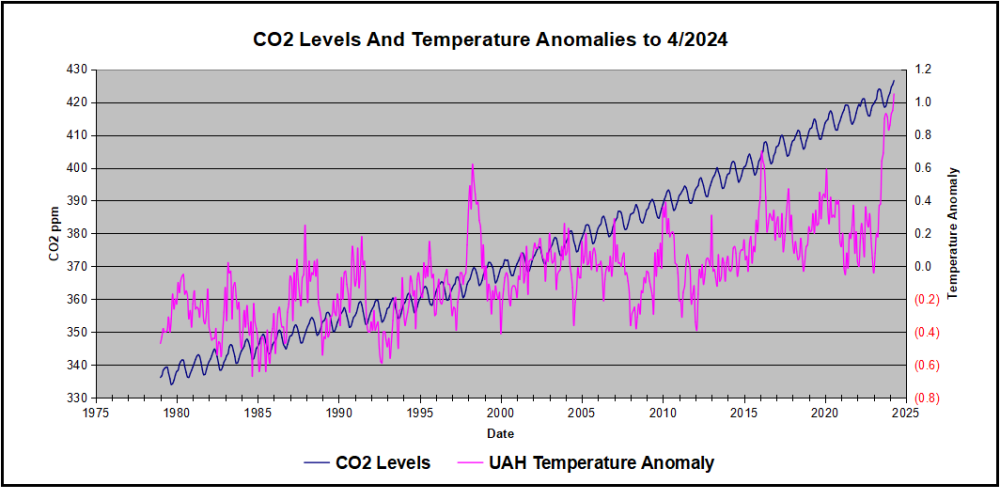
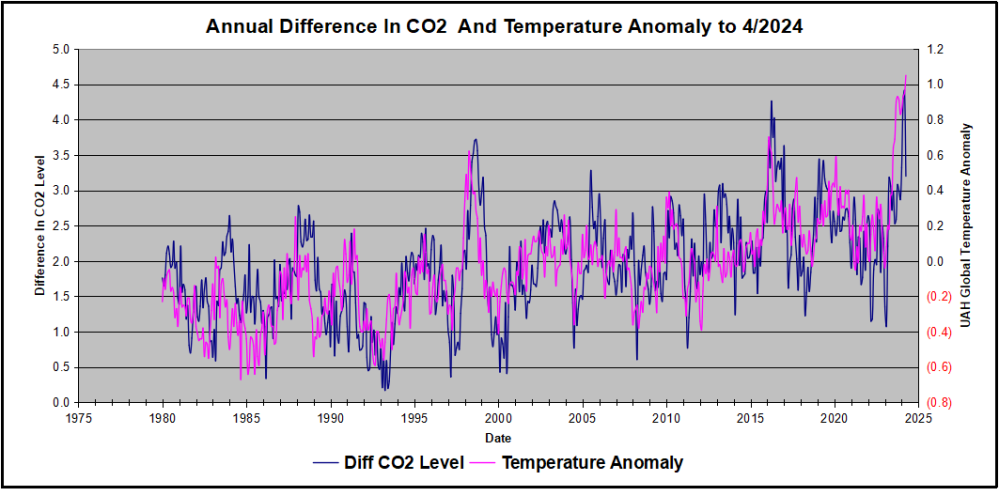
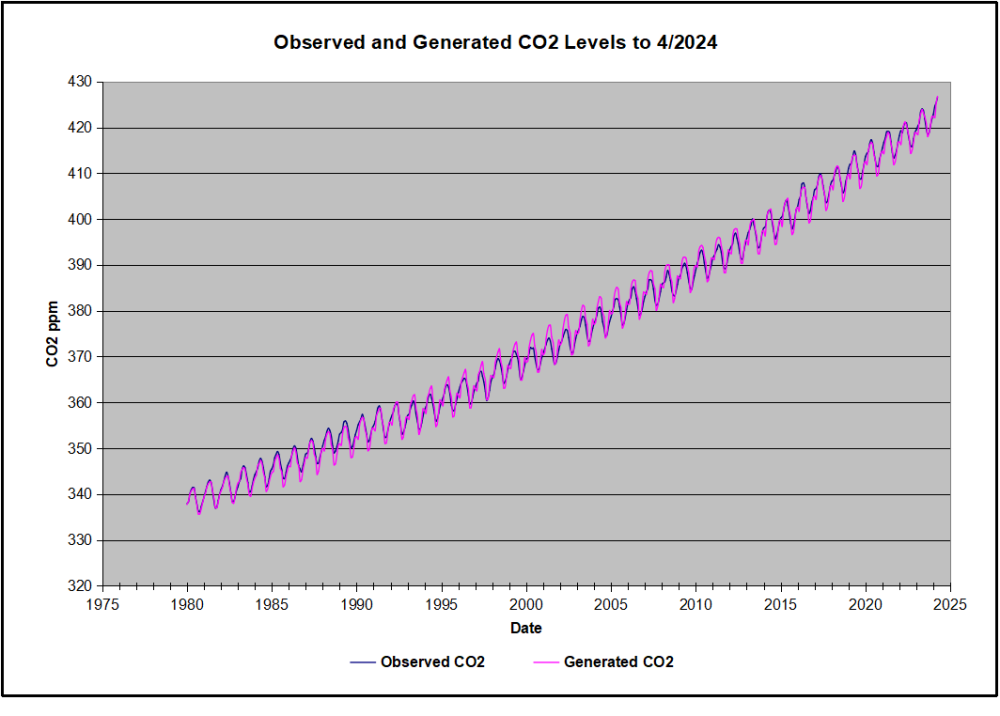
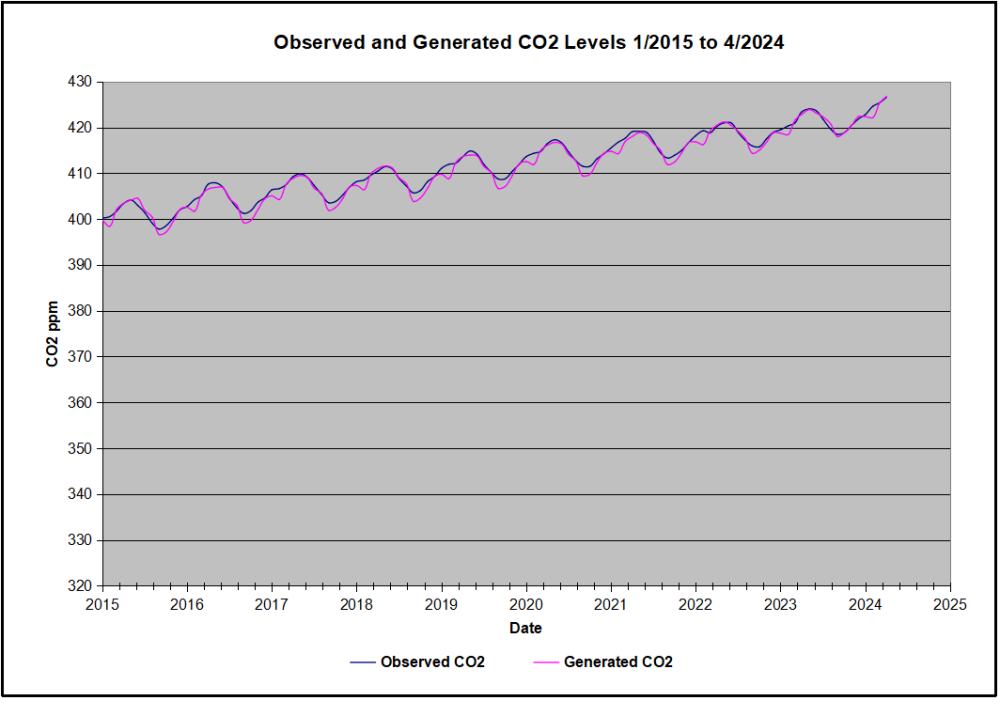
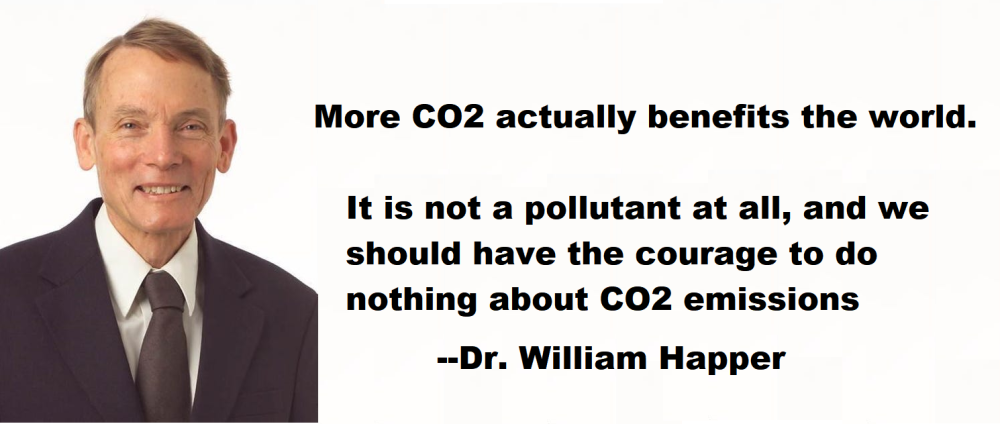
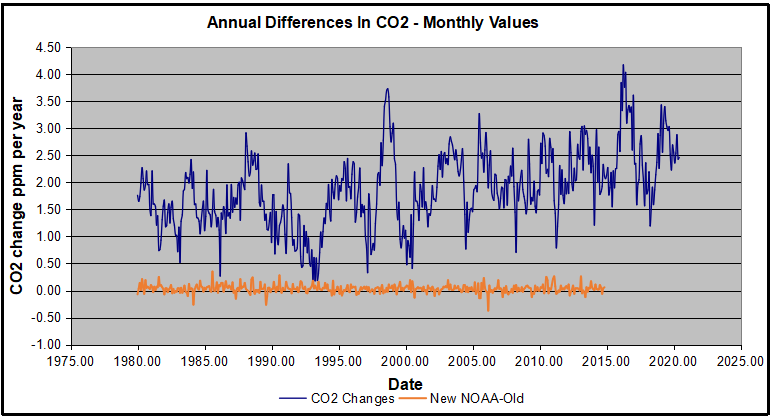
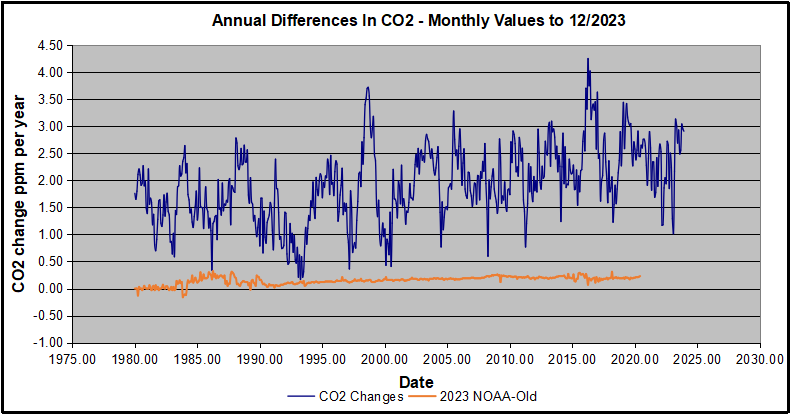
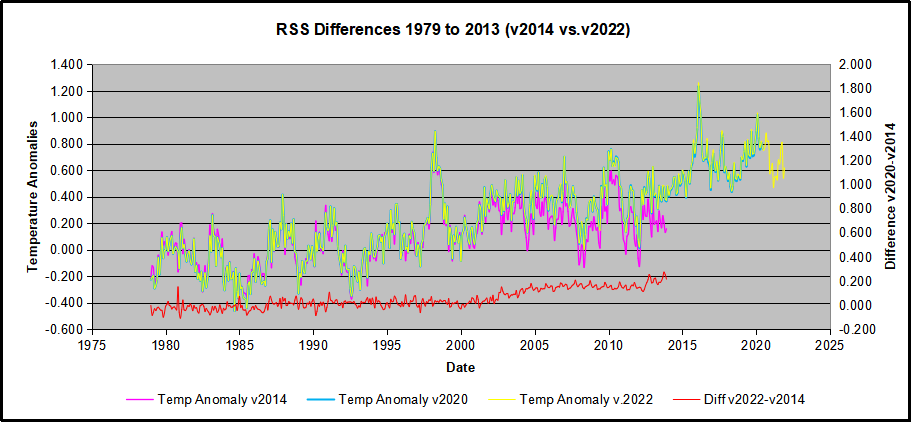



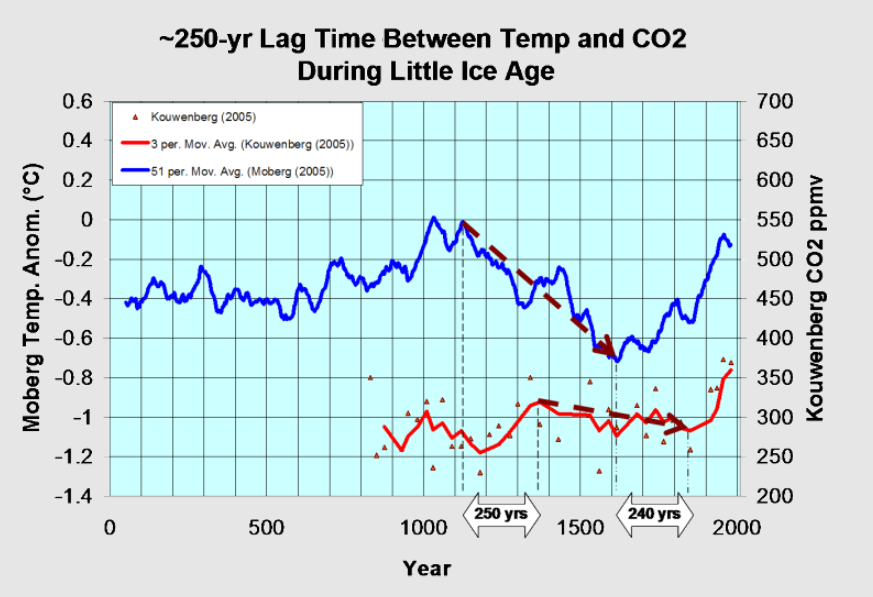
Climate alarmists have lost the ability to discriminate between cause and effect. Seriously, there are people on X shouting loudly about the record jump in CO2 and linking that directly to the record rise in global temperature, seemingly oblivious to the fact that the global temperature started spiking 9 months before CO2 went up! It’s unbelievable.
LikeLike
Thanks for that Jaime, it seems it was a good time to sort out cause and effect. Those folks on X are probably also concerned about this issue:
https://rclutz.com/2020/08/23/silly-science-questions/
LikeLike
On a more serious note,
Your comment raises another reason this post is important. Frequently zero carbon folks will readily admit that over centuries and millenia, changes in CO2 did mostly follow rather than lead temperature changes. But they then go on to say that once humans started burning hydrocarbons, we added CO2 much faster than the natural sources which operate more slowly. In fact they will assert, all of the increase since the industrial revolution to now was from human activities.
Two points: Firstly, this mathematical model shows that the time for CO2 to respond to rising temperatures can be a matter of months, when we have the measuring instruments to record the changes. Secondly, we have the impression that natural CO2 processes are slow because we rely on proxies where changes are discerned at best over centuries or millenia. What modern instruments would have recorded in ancient times is a mystery. The proxies show a rapid (for them) drop of CO2 as the Younger Dryas cooling occurred, which could well have been experienced over annual or decadal periods, like today.
It is also important to note the scale of things, alluded to in the last part of the post.
Our planet keeps cycling carbon through many reservoirs which serve as both sinks and sources. Of the three places where carbon is stored—atmosphere, oceans, and land biosphere—approximately 93 percent of the CO2 is found in the oceans. The oceans contain about 50 times more CO2 than the atmosphere and 19 times more than the land biosphere. My last post demonstrates that rising temperatures cause the ocean and biosphere reservoirs to release more CO2 and absorb less CO2. The reverse happens when temperatures decline. This patten is also seen in the seasonal highs and lows of annual CO2 levels in the atmosphere.
And the oceanic processes are known to function in both short and long term, as Segalstad diagramed below.
LikeLike
Hi Ron, thanks for the post. Considering that CO2 has been declining for the last few million years, down to 180 ppm at the end of the last ice age, the current 400+ ppm should be considered a blessing. There seems to be a backlash with rising energy costs for industry and households, the only question is whether it will be enough to shift the focus away from the green agenda to a more holistic economic approach that doesn’t just focus on renewables. Reliable energy sources such as nuclear have been demonised for too long. This needs to change if we are to provide reliable electricity to meet the growing demands of the future. Centralised energy production is the most efficient way to ensure a nation’s growth and stability. The idea that renewables will meet future demand is simply not possible and will cost much more. The public just doesn’t understand how complex the grid is and how much more complex it is to manage a grid with renewables. VR
LikeLike
Thanks VR for your comment. It’s true that finally some in the energy sector are pushing back on the extremely dangerous green agenda. It is doubly wrong-headed: our miniscule emissions will not stop the warming that started after the LIA. But once a cooling off starts, we will need all the energy we can get.. Ironically, as this post shows, cooling temperatures will naturally lead to less CO2, but hopefully not too much lower for the sake of plant and animal life.
LikeLike
It seems to me that it’s temperature that has the biggest impact on CO2, not the other way around. It’s the elephant in the room that nobody wants to admit. The big question is why we have been on such a long downward trend over the last few million years, with so many repeated ice ages and very short warm periods.
If this downward trend in CO2 starts again with the start of the next ice age, it wouldn’t hurt if we could add a bit more to keep the levels up for plant life. I could see a demonstration in a few thousand years time with people sticking themselves to the roads to demand more CO2 😉 Save plants and the planet!!!!
I think I’ll go and do this now, start t new trend, more CO2 to save the planet, humans, animals and plants!
Cheers VR
LikeLike
Well, the longer millions of years trend is mostly caused by solar and planetary orbital cycles.
But you’re entirely correct that life on Earth prospered through the ages with much more CO2 than now.
LikeLike
I’ll bet it’s been challenging for CASIO to minimize curtailment on their grid with the fire down near San Diego-
https://stephenheins.substack.com/p/battery-fire-at-storage-facility?
With the second Diablo reactor coming online last week the curtailment for May is going to blow past its previous record. It was rather large on the 26th-
Click to access Wind_SolarReal-TimeDispatchCurtailmentReportMay26_2024.pdf
Mark
LikeLike
Good point kakatoa, the duck curve now looks like a canyon
LikeLike